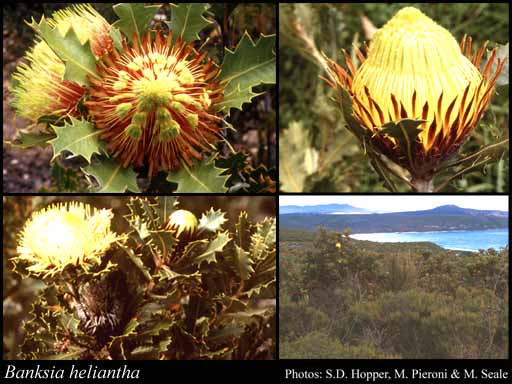- Reference
- Austral.Syst.Bot. 20:65 (2007)
- Conservation Code
- Not threatened
- Naturalised Status
- Native to Western Australia
- Name Status
- Current
Robust, openly-branched, non-lignotuberous shrub, 0.6-3 m high. Fl. yellow/yellow-orange, Mar or Jul to Oct. Rocky soils over laterite, quartzite or shale, white sand. Slopes & tops of hills.

Scientific Description
Shrubs, 1-1.5 m high; branchlets hairy. Leaves petiolate, alternate, 50-90 mm long, 22-50 mm wide, hairy; petiole 8-10 mm long; lamina flat, clearly widest above the middle, once divided, pinnately divided, shallowly divided, teeth distinctly pointing towards the apex or teeth pointing outwards, with 5-15 lobes on each side, the margins flat. Inflorescences tomentose (with matted or tangled, soft, woolly hairs), yellow; innermost bracts 35-44 mm long, hairy. Perianth 35-40 mm long, hairy, all over, limb apex hirsute (with long, rough and coarse hairs), without awns; pistil 45-50 mm long, curved, style glabrous. Follicles hairy, tomentose (with matted or tangled, soft, woolly hairs), obovate, 15-20 mm long. Flowers in August, September, October or November. Occurs in the South-west (SW) Botanical Province(s), in the Mallee (MAL) or Esperance Plains (ESP) IBRA subregion(s).
Distribution
- IBRA Regions
- Esperance Plains, Mallee.
- IBRA Subregions
- Fitzgerald, Recherche, Western Mallee.
- Local Government Areas (LGAs)
- Jerramungup, Kent, Ravensthorpe.